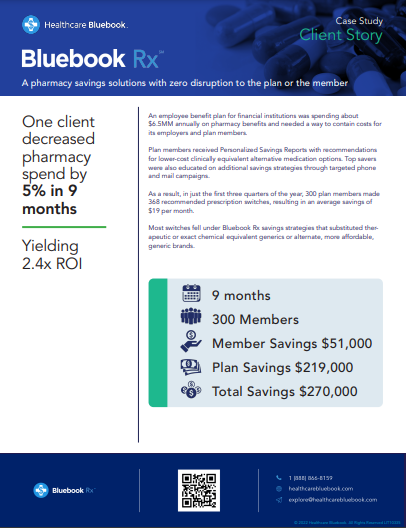-1.jpeg?width=1000&height=667&name=AdobeStock_717197856%20(1)-1.jpeg) The popularity of glucagon-like peptide-1 (GLP-1) weight loss drugs is on the rise, offering transformative health benefits for those struggling with obesity. For employers, these medications present a unique opportunity to improve employee well-being while addressing the substantial financial implications of chronic health conditions.
The popularity of glucagon-like peptide-1 (GLP-1) weight loss drugs is on the rise, offering transformative health benefits for those struggling with obesity. For employers, these medications present a unique opportunity to improve employee well-being while addressing the substantial financial implications of chronic health conditions.
That said, the high costs of GLP-1 drugs raise questions about how to balance immediate expenses with long-term savings. The truth is, while GLP-1 weight loss drugs are costly, their potential to reduce both obesity-related illnesses and overall healthcare costs can create significant value for employers committed to workforce health. Solutions like those offered by Healthcare Bluebook, now part of Vālenz Health®, can help employers make informed decisions to manage costs while improving health outcomes.
Positive Impacts of GLP-1 Weight Loss Drug Coverage
Employers who invest in their workforce’s health stand to gain more than just a healthier team—they also unlock key operational benefits, such as:
Reduced Absenteeism
GLP-1 weight loss drugs help employees achieve and maintain a healthy weight. These medications also improve their ability to manage chronic conditions, such as diabetes and hypertension. With better health, employees experience fewer sick days, reducing absenteeism and the costs associated with lost productivity.
Lower Healthcare Costs
Obesity contributes to several chronic illnesses, which often result in substantial healthcare expenses. By promoting weight loss, GLP-1 drugs can help mitigate these conditions, leading to fewer medical claims and reduced healthcare spending for both employers and employees.
Higher Employee Satisfaction
Employers that offer GLP-1 coverage demonstrate a commitment to employee health and well-being, which can, in turn, boost morale and satisfaction. Research shows that healthier, happier employees are more engaged, productive, and loyal, which creates a ripple effect of benefits across the organization.
Challenges of Covering GLP-1 Weight Loss Drugs
While the benefits of GLP-1 medications are promising, their adoption isn’t without hurdles. Employers are tasked with weighing these advantages against challenges such as:
High Up-Front Costs
The price of GLP-1 drugs often exceeds $1,000 a month per patient. For employers, offering GLP-1 weight loss coverage can increase the organization’s healthcare expenses, initially straining benefits budgets. Employers may need to raise insurance premiums to offset the costs of GLP-1 coverage, and while these adjustments can help manage expenses, they can also impact employees’ out-of-pocket costs and overall satisfaction.
Patient Adherence
Research shows that many patients stop taking GLP-1 weight loss drugs within the first year due to cost and side effects, which can ultimately lead to weight regain. This pattern of patient nonadherence raises concerns about the return on investment for employers covering these medications.
Long-Term Contracts
For some patients, GLP-1 drugs require long-term use to maintain results. Sustaining these prescriptions over extended periods can create financial challenges for both employers and employees.
Strategies to Help Manage the Costs of GLP-1 Drugs
To maximize the value of GLP-1 coverage and help with managing costs, employers can implement thoughtful strategies that make these medications more accessible and affordable. Some proven approaches include:
Utilization Management
Employers can implement measures such as prior authorization, ensuring GLP-1 prescriptions are reserved for employees who meet specific clinical criteria, such as those with a high body mass index or related chronic conditions, such as diabetes or hypertension. This approach promotes responsible use and minimizes unnecessary costs.
Bundling Benefits
Integrating GLP-1 coverage with broader health and wellness programs can make these medications more affordable for employers and employees alike. For instance, bundling weight loss drugs with diabetes management services may provide added value while also reducing overall costs.
Patience Assistance
Employers can partner with pharmaceutical companies to access patient assistance programs, which often provide discounts or subsidies. These programs make GLP-1 drug coverage more attainable and sustainable across the board.
How Healthcare Bluebook Can Help with GLP-1 Weight Loss Drug Coverage
Employers face the challenge of supporting workforce health while controlling escalating healthcare costs. Approximately 20 percent of an employer’s medical spend consists of pharmacy expenses, with 10-30 percent of that representing avoidable waste.
Navigating the complexities of GLP-1 drug coverage can be daunting, but employers don’t have to face these challenges alone. Bluebook Rx™, now part of Valenz Health, helps employers reduce pharmacy spend while improving employee well-being. This innovative solution engages members and leverages data analysis to identify savings opportunities.
By combining medical and pharmacy navigation into one unique platform, Bluebook Rx empowers employers to maximize the value of their healthcare investment. Take one success story for example: Using Bluebook Rx, one client decreased pharmacy spend by 5 percent in just nine months, achieving both plan and member savings.
Explore the full case study to see how Bluebook Rx can support your organization and achieve results like these.

